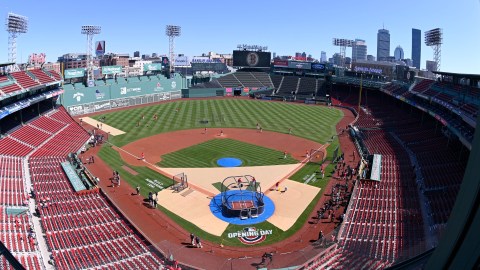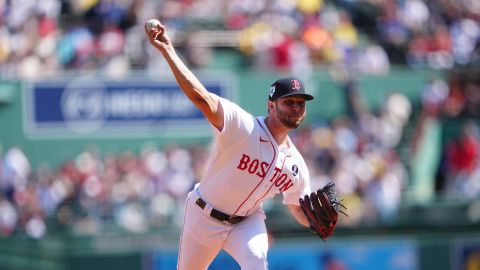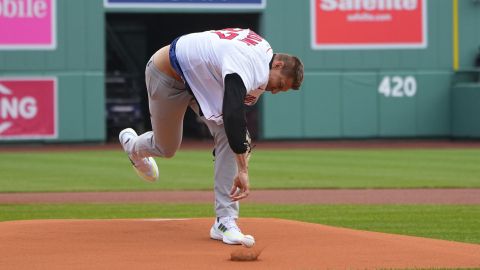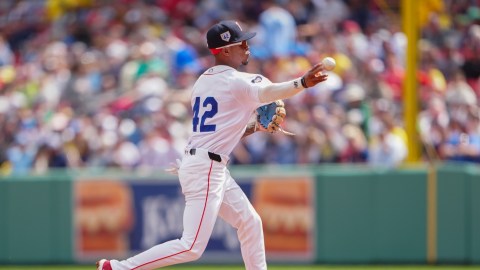 While Koji Uehara is not the answer to all of the Red Sox’ problems, he will go a long way toward stabilizing the Boston bullpen. The true stability of the unit, however, relies largely on the shoulders of those hurlers already in house.
While Koji Uehara is not the answer to all of the Red Sox’ problems, he will go a long way toward stabilizing the Boston bullpen. The true stability of the unit, however, relies largely on the shoulders of those hurlers already in house.
The Red Sox’ 2012 pitching were well-documented, and they were ultimately a big reason — perhaps the biggest — for the team’s disappointing 69-93 finish. Much of the blame deserves to be placed on the team’s starters, as they failed to provide consistent innings, which in turn taxed the bullpen time and time again. The hope in Boston is that Jon Lester, Clay Buchholz, John Lackey and Co. can bounce back — with perhaps a little help from Ryan Dempster — to turn around the rotation’s fortunes. Questions still remain, though, and that makes figuring out the bullpen an even more vital task than usual.
The Red Sox took a step toward ensuring the pen will be able to hold up in 2013 by signing Uehara to a one-year deal worth a reported $4.25 million. The Japanese product will turn 38 in April, but his track record in his four big league seasons speaks for itself.
Uehara finished the 2012 campaign with a 1.75 ERA and a 0.64 WHIP in 36 innings spread out over 37 appearances with the Rangers. He also put together a 14.33 strikeout-to-walk ratio, which is one of the best such figures in baseball history. In fact, only Dennis Eckersley has put together a better single-season figure since 1900, and Uehara’s career 7.97 strikeout-to-walk ratio is the best to date.
Obviously, as is always the case with a 37-year-old pitcher coming off a season in which he battled a strained lat, there exists some risk. But Uehara’s transition to the bullpen after 12 mediocre starts with the Orioles in 2009 has been as smooth as silk, and there’s a good chance he’ll enjoy success in Boston, especially since he isn’t overly reliant on pure “stuff” to get hitters out. After all, Uehara’s fastball generally sits below 90 mph.
But while Uehara will bolster the bullpen, he is no way, shape or form the answer to all of Boston’s pitching issues. Those problems will have to be hashed out among the pitchers already on the roster, and while much of the responsibility falls on the starters, the team’s bullpen remains a wild card.
The Red Sox’ bullpen wasn’t exactly terrible in 2012. As mentioned, the unit was often placed in difficult situations, so it’s probably unfair to judge the unit by its 19th-ranked ERA (3.88), its 18th-ranked WHIP (1.29) or its 18th-ranked batting average against (.240). But clearly, there’s still room for improvement, and the encouraging sign is that there are relievers already in the mix who could stand to improve in 2013.
At the forefront is Andrew Bailey, who figures to be the team’s closer come Opening Day. Bailey, of course, missed a big chunk of last season with a thumb injury, and didn’t appear in a game until Aug. 14. Even upon his return, Bailey wasn’t exactly the lights-out closer Red Sox fans were hoping that they obtained from Oakland, although the 7.04 ERA is somewhat skewed by the minimal innings and a five-run, 1/3-inning shellacking he suffered at the hands of the Rays on Sept. 20.
Bailey is back and fully healthy, and his track record — like Uehara’s — seems to indicate that success could be on the horizon. The two-time All-Star saved 75 games in three seasons with the A’s while compiling a 2.47 ERA, including a pretty 1.47 mark in 2010. We’ll have to see how Bailey can handle the big stage of Boston while implanted as the permanent closer, but the talent is there for the 28-year-old righty.
Perhaps the bigger question is getting to Bailey. Uehara will help, and his fellow countryman Junichi Tazawa pitched very well for Boston last year, but there are two guys in particular who will need to assemble better seasons.
First, there’s Mark Melancon. Melancon actually pitched well down the stretch, allowing just one run in 10 September/October innings, but his season as a whole was a train wreck. He’ll need to show that he’s ready to put it all together for a full season in 2013, and prove that his stint in Pawtucket truly was an eye-opener.
Melancon’s success in Houston, which included eight wins and 2.78 ERA in 71 appearances in 2011, needs to replicated, especially if he’d like to return to a late-inning role — as he’s suggested he would like to.
Then, there’s Daniel Bard. While this offseason has been full of acquisitions and inquiries, last winter’s biggest question mark was Bard’s role heading into the season. It also turned out to be one of the Red Sox’ biggest flubs, as the starting experiment is one that clearly didn’t work.
No one really knows what to expect from Bard in 2013, especially since he was just as awful — perhaps worse — after being demoted to the minors. But if the 27-year-old can find a sliver of what made him perhaps Boston’s most reliable reliever for three seasons, then the Red Sox’ bullpen will be in much better shape, particularly if its forced into less-than-ideal situations again due to inconsistent starting pitching.
Signing Uehara was a step toward solving those bullpen problems that existed in 2012. The giant leap, however, is reliant upon self-improvement from those already donning Red Sox uniforms.
Koji Uehara photo (center) via Flickr/mikelachance816




